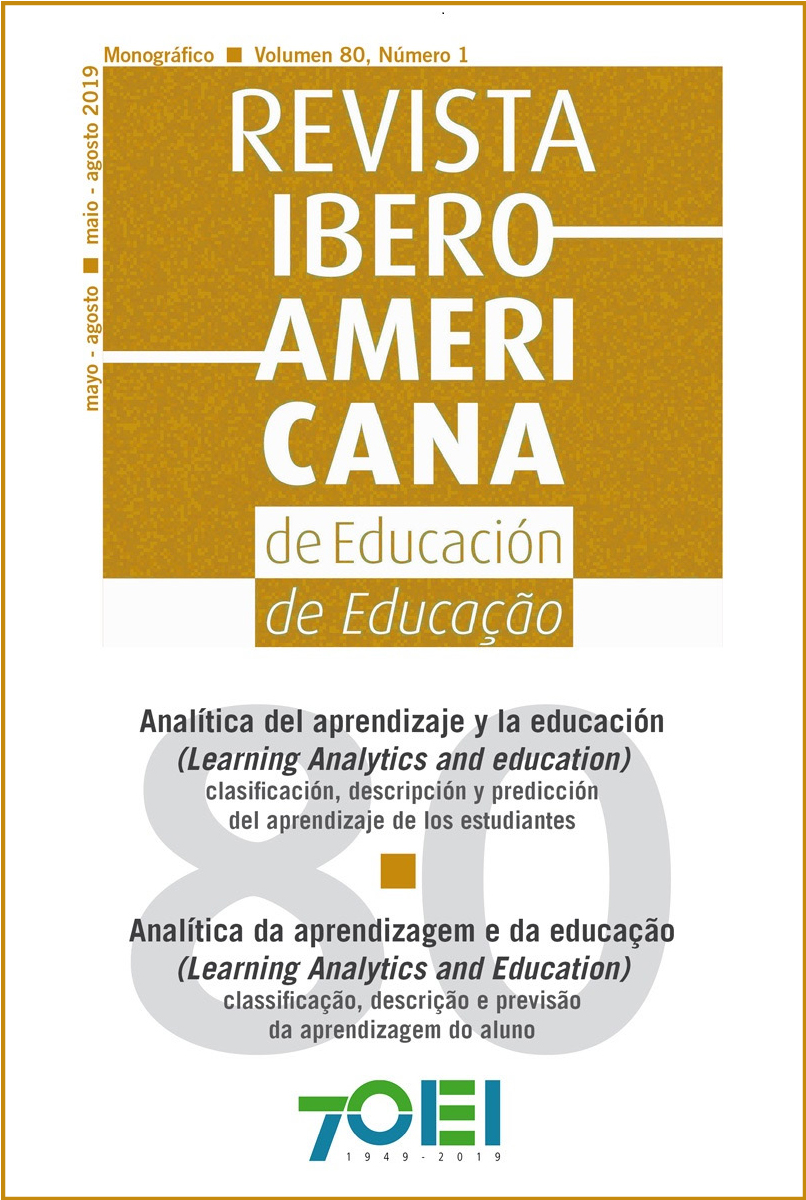Developing a pilot Learning Analytic tool for the improvement of collaborative processes in Blackboard platform
DOI:
https://doi.org/10.35362/rie8013461Keywords:
collaborative learning, digital technology, higher education, knowledge construction, virtual learning.Abstract
This work presents a study focused on a set of indicators related to the model of distributed educational influence that helps the design of a Learning Analytic to provide formative feedback. It explores the effect of providing information related to such model on the collaborative processes of the participants in Blackboard digital environment. A qualitative case study was conducted with 24 undergraduate students who participated in five online discussion forums. The results suggest that providing information has an effect on the improvement of collaborative processes just at the initial phases. It is concluded that the information related to the theoretical model has a greater effect on the collaborative processes of the groups that handled this information; the above idea reinforces the interest to analyze, in depth, the particular dynamics of each group to understand the effect of the information on the configuration of such dynamics.
Downloads
References
Bustos, A. (2011). Presencia docente distribuida, influencia educativa y construcción del conocimiento en entornos de enseñanza y aprendizaje basados en la comunicación asíncrona escrita. Tesis doctoral. Universidad de Barcelona. Recuperado de https://bit.ly/2IR7mF2
Bustos, A., Coll, C., y Engel, A. (2009). Presencia docente distribuida en redes asíncronas de aprendizaje. Definición teórica y perspectiva multimétodo para su estudio. En F. Díaz Barriga, G. Hernández, y M. Rigo (Eds.), Aprender y enseñar con TIC en educación superior: contribuciones del socioconstructivismo (pp. 97-128). México: Publicaciones Universidad Nacional Autónoma de México.
Coll, C. (2010). Enseñar y aprender, construir y compartir: procesos de aprendizaje y ayuda educativa. En C. Coll (Coord.), Desarrollo, aprendizaje y enseñanza en la Educación Secundaria (pp. 31-62). Barcelona: Graó
Coll, C., Bustos, A., y Engel, A. (2011). Perfiles de participación y presencia docente distribuida en redes asíncronas de aprendizaje: la articulación del análisis estructural y de contenido. Revista de Educación, 354, 657–688. Recuperado de https://bit.ly/2US9mOK
Coll, C., Bustos, A. y Engel, A. (2015). La información sobre el ejercicio de la influencia educativa como medio para favorecer la participación y el aprendizaje en un foro en línea. Infancia y Aprendizaje, 38, 368-401. doi:10.1080/02103702.2015.1016745
Coll, C., Bustos, A., Engel, A., de Gispert, I., y Rochera, M. J. (2013). Distributed Educational Influence and Computer-Supported Collaborative Learning. Digital Education Review, 24, 23-42. Recuperado de https://bit.ly/2J4ME3B
Coll, C., Colomina, R., Onrubia, J., y Rochera, M. J. (1992). Actividad conjunta y habla: una aproximación a los mecanismos de influencia educativa. Infancia y Aprendizaje, 59-60, 189-132. Recuperado de https://bit.ly/2GTAQQo
Coll, C., Engel, A., y Bustos, A. (2009). Distributed Teaching Presence and Participants’ Activity Profiles: a theoretical approach to the structural analysis of Asynchronous Learning Networks. European Journal of Education, 44(4), 521-538. doi:10.1111/j.1465-3435.2009.01406.x
Coll, C., Engel, A., y Niño, S. (2017). La actividad de los participantes como fuente de información para promover la colaboración. Una analítica del aprendizaje basada en el modelo de Influencia Educativa Distribuida. RED Revista de Educación a Distancia, 53. doi:10.6018/red/53/2
Coll, C., Onrubia, J., y Mauri, T. (2008). Ayudar a aprender en contextos educativos: el ejercicio de la influencia educativa y el análisis de la enseñanza. Revista de Educación, 346, 33-70. Recuperado de https://bit.ly/2vvqUGe
Colomina, R., Onrubia, J., y Rochera, M. J. (2001). Interactividad, mecanismos de influencia educativa y construcción del conocimiento en el aula. En C. Coll, J. Palacios, y A. Marchesi (Comps.). Desarrollo Psicológico y educación. Vol. II. Psicología de la Educación (pp. 415-435). Madrid: Alianza.
Dawson, S., y Siemens, G. (2014). Analytics to Literacies: The development of a learning analytics framework for multiliteracies assessment. The International Review of Research in Open and Distance Learning, 15(4), 284-305. Recuperado de https://bit.ly/2IQX2gi
Dehler, J., Bodemer, D., Buder, J., y Hesse, F. W. (2011). Guiding knowledge communication in CSCL via group knowledge awareness. Computers in Human Behavior, 27(3), 1068-1078. doi:10.1016/j.chb.2010.05.018
Dillenbourg, P., Järvelä, S., y Fischer, F. (2009). The evolution of research on computer-supported collaborative learning: from design to orchestration. En N. Balacheff, S. Ludvigsen, T. de Jong, T., A. Lazonder y S. Barnes (Eds.), Technology-Enhanced Learning. Principles and products (pp. 3-19). Springer, Dordrecht.
Dimitracopoulou, A. (2008). Computer based Interaction Analysis Supporting Self-regulation: Achievements and Prospects of an Emerging Research Direction. Technology, Instruction, Cognition and Learning, 6(4), 291-314. Recuperado de https://bit.ly/2DE547K
Durall, E., y Gros, B. (2014). Learning analytics as a metacognitive tool. In Proceedings of 6th International Conference on Computer Supported Education (CSEDU) (pp. 380–384). Recuperado de https://bit.ly/2XPw5ge
Engel, A., Coll, C., y Bustos, A. (2013). Distributed Teaching Presence and communicative patterns in asynchronous learning: Name versus reply networks. Computers y Education, 60, 184-196. doi:10.1016/j.compedu.2012.06.011
Ferguson, R. (2012). The State Of Learning Analytics in 2012: A Review and Future Challenges. Technical Report KMI-12-01, Knowledge Media Institute, The Open University, UK. Recuperado de https://bit.ly/2WaE8ns
García, E., Romero, C., Ventura, S., y de Castro, C. (2011). A collaborative educational association rule mining tool. The Internet and Higher Education, 14(2), 77-88. doi:10.1016/j.iheduc.2010.07.006
Gros, B. (2016). The design of smart educational environments. Smart Learning Environments, 3(15), 1-11. doi:10.1186/s40561-016-0039-x
Jeong, H., y Hmelo-Silver, C. E. (2016). Seven affordances of computer-supported collaborative learning: How to support collaborative learning? How can technologies help? Educational Psychologist, 51, 247–265. doi:10.1080/00461520.2016.1158654
Kirschner, P. A., y Erkens, G. (2013). Toward a Framework for CSCL Research. Educational Psychologist, 48, 1–8. doi:10.1080/00461520.2012.750227
Siemens, G. y Long, P. (2011). Penetrating the Fog: Analytics in learning and Education. EDUCAUSE Review 46(5), 30-40. Recuperado de https://bit.ly/1xlMCED
Stahl, G., Koschmann, T., y Suthers, D. (2006). Computer-supported collaborative learning: An historical perspective. En R. K. Sawyer (Ed.), Cambridge handbook of the learning sciences (pp. 409-426). Cambridge, UK: Cambridge University Press. Recuperado de https://bit.ly/2vvrtzQ
Yin, R. K. (2006). Case Study methods. En J. L. Green, G. Camilli, y P. B. Elmore (Eds.), Handbook of Complementary Methods in Education Research (pp. 111-122). Mahwah, NJ: L. Erlbaum.
How to Cite
Downloads
Published
Issue
Section
License
Any authors who publish with this journal accept the following terms:















